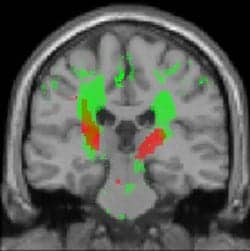New research [removed]reported[/removed] by the Rehabilitation Institute of Chicago (RIC), indicates that combining a common antidepressant medication with intensive walking training may provide a new approach for recovering walking ability in patients suffering from spinal cord injury.
According to RIC researchers, patients with partial recovery of voluntary strength after a spinal cord injury who received the common antidepressant medication escitalopram while undergoing intensive walking training showed greater recovery of their walking ability than those receiving a placebo prior to each training session. Escitalopram, a selective serotonin reuptake inhibitor (SSRI), is a commonly prescribed medication for the treatment of depression. SSRIs are thought to relieve these symptoms by blocking the re-absorption of serotonin by certain nerve cells in the brain. Serotonin also has been shown to facilitate normal communication between the brain and the spinal cord, which may be reduced substantially following spinal cord injury.
“These results show a stark contrast to the typical school of thought regarding the use of a prescription medication for improving motor function, and suggest that people with spinal cord injury and some residual motor function may benefit from administration of SSRIs when performing intensive walking training,” said T. George Hornby, PT, PhD, director of the Neurolocomotion Lab at RIC, in a statement released by the facility. “We are working to apply the promise of this new approach to current patients and will soon begin clinical trials at RIC to determine if intervention earlier in the recovery process may also provide benefits and help patients regain walking ability.”
The research included 50 patients with some residual motor function 1 year removed from their initial spinal cord injury. Patients received up to 24 sessions of intensive walking on a motorized treadmill over the course of 8 weeks, in addition to 10 mg of either the SSRI, escitalopram, or placebo agent 5 hours prior to each training session. Patients received up to 40% body weight support and therapist or robotic-assistance as needed to facilitate continuous walking. Results were measured by the fastest possible walking velocity performed, with secondary measures including balance, strength, spastic reflexes, measures of depression and lower limb coordination, and muscle activation patterns during treadmill walking.
In general, patients receiving the SSRI treatment in combination with intensive walking training showed a significantly greater improvement in peak treadmill speeds (mean: 1.03 +/- SD: 0.76 m/s), compared to patients receiving SSRI treatment only (0.41 +/- 0.49, p < 0.01), said RIC. The differences in the groups were primarily due to significantly improved length of stride (p < 0.01) with nonsignificant differences in cadence (p = .20).
One patient enrolled in the study, 50-year-old Lisa Hurst from Evanston, Ill, reported experiencing significant progress from escitalopram combined with intensive walking therapy. Lisa’s spinal cord injury stemmed from a spinal infarction in 2003 that lead to temporary paralysis over most of her body and continued impairment once she began to regain movement in her limbs. She joined the RIC study in 2007 to challenge herself to regain more walking ability in her recovery, and was part of the group that received SSRI treatment in addition to the walking therapy. Her treatment goal was to track longer distances at faster speeds, and she reports that the therapy she received at RIC helped her gain physical strength and coordinate her arm movements with her leg movements to make walking a more seamless process.
RIC operates its 165-bed, flagship hospital in downtown Chicago, and a network of 30 sites of care located throughout the city and surrounding suburbs that provide additional inpatient care, day rehabilitation, and outpatient services.
[Source: [removed]RIC[/removed]]




